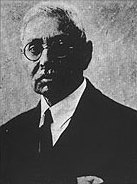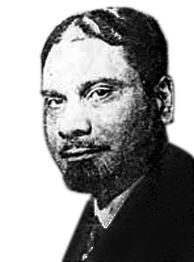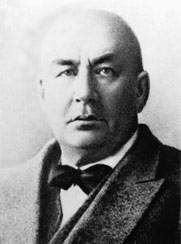
European influence in Afghanistan has been present in the country since the Victorian era, when the competing imperial powers of Britain and Russia contested for control over Afghanistan as part of the Great Game.

Raja Mahendra Pratap was an Indian freedom fighter, journalist, writer, revolutionary, President in the Provisional Government of India, which served as the Indian Government-in-exile during World War I from Kabul in 1915, and social reformist of British India. He also formed the Executive Board of India in Japan in 1940 during the Second World War. He formed the original Indian National Army in 1915 in Kabul which was supported by many Nations including Japan. He also took part in the Balkan War in the year 1911 along with his fellow students of Muhammadan Anglo-Oriental College. He is popularly known as "Aryan Peshwa".

Mohamed Barakatullah Bhopali, known with his honorific as Maulana Barkatullah, was an Indian revolutionary from Bhopal. Barkatullah was born on 7 July 1854 at Itawra mohalla, Bhopal in what is today Madhya Pradesh, India. He fought from outside India, with fiery speeches and revolutionary writings in leading newspapers, for the independence of India. He did not live to see India independent. He died at San Francisco in 1927 and buried at Sacramento City Cemetery California. In 1988, Bhopal University was renamed Barkatullah University in his honour. He was also Prime Minister of first Provisional Government of India established at Afghanistan in 1915.

Chempakaraman Pillai was an Indian-born political activist and revolutionary. Born in Thiruvananthapuram, to Tamil Pillai parents, he left for Europe as a youth, where he spent the rest of his active life as an Indian nationalist and revolutionary.

Ubaidullah Sindhi was a political activist of the Indian independence movement and one of its vigorous leaders. According to Dawn, Karachi, Maulana Ubaidullah Sindhi struggled for the independence of British India and for an exploitation-free society in India. He was also Home Minister of first Provisional Government of India established in Afghanistan in 1915.
The following lists events that happened during 1919 in Afghanistan.
The Hindu–German Conspiracy(Note on the name) was a series of attempts between 1914 and 1917 by Indian nationalist groups to create a Pan-Indian rebellion against the British Empire during World War I. This rebellion was formulated between the Indian revolutionary underground and exiled or self-exiled nationalists in the United States. It also involved the Ghadar Party, and in Germany the Indian independence committee in the decade preceding the Great War. The conspiracy began at the start of the war, with extensive support from the German Foreign Office, the German consulate in San Francisco, and some support from Ottoman Turkey and the Irish republican movement. The most prominent plan attempted to foment unrest and trigger a Pan-Indian mutiny in the British Indian Army from Punjab to Singapore. It was to be executed in February 1915, and overthrow British rule in the Indian subcontinent. The February mutiny was ultimately thwarted when British intelligence infiltrated the Ghadarite movement and arrested key figures. Mutinies in smaller units and garrisons within India were also crushed.

The Niedermayer–Hentig Expedition, also known as the Kabul Mission, was a diplomatic mission to Afghanistan sent by the Central Powers in 1915–1916. The purpose was to encourage Afghanistan to declare full independence from the British Empire, enter World War I on the side of the Central Powers, and attack British India. The expedition was part of the Hindu–German Conspiracy, a series of Indo-German efforts to provoke a nationalist revolution in India. Nominally headed by the exiled Indian prince Raja Mahendra Pratap, the expedition was a joint operation of Germany and Turkey and was led by the German Army officers Oskar Niedermayer and Werner Otto von Hentig. Other participants included members of an Indian nationalist organisation called the Berlin Committee, including Maulavi Barkatullah and Chempakaraman Pillai, while the Turks were represented by Kazim Bey, a close confidante of Enver Pasha.
The Berlin Committee, later known as the Indian Independence Committee after 1915, was an organisation formed in Germany in 1914 during World War I by Indian students and political activists residing in the country. The purpose of the committee was to promote the cause of Indian Independence. Initially called the Berlin–Indian Committee, the organisation was renamed the Indian Independence Committee and came to be an integral part of the Hindu–German Conspiracy. Members of the committee included Virendranath Chattopadhyaya, Chempakaraman Pillai, Dr Jnanendra Das Gupta, and Abinash Bhattacharya.

The Silk Letter Movement refers to a movement organised by Deobandi leaders between 1913 and 1920, aimed at gaining Indian independence from British rule by forming an alliance with the Ottoman Empire, the Emirate of Afghanistan and the German Empire. This plot was uncovered by the Punjab CID with the capture of letters from Ubaidullah Sindhi, one of the Deobandi leaders then in Afghanistan, to Mahmud Hasan Deobandi, another leader then in Hejaz. The letters were written on silk cloth, hence the name.
The Rowlatt Committee was a Sedition Committee appointed in 1917 by the British Indian Government with Sidney Rowlatt, an Anglo-Egyptian judge, as its president.
The Hindu–German Conspiracy failed to engage popular support within India. However, it had a significant impact on Britain's policies both in the empire, as well as on her international relations. The outlines and plans for the nascent ideas of the conspiracy were noted and began to be tracked by the British intelligence as early as 1911. Alarmed at the agile organisation, which repeatedly reformed at different parts of the country despite being subdued in others, the chief of Indian Intelligence Sir Charles Cleveland was forced to warn that the idea and attempt at pan-Indian revolutions were spreading through India "like some hidden fire". A massive, concerted and coordinated effort was required to subdue the movement. Attempts were made in 1914 to prevent the naturalisation of Tarak Nath Das as an American citizen, while successful pressure was applied to have Har Dayal interned. The conspiracy had been detected early by British intelligence, and had been the subject of strong British pressure from 1914.
Heramba Lal Gupta( C.1884-1950) was an Indian nationalist linked to the Berlin Committee and the Ghadar Party extensively involved in the Hindu–German Conspiracy, who later became a British Intelligence mole inside Mahendra Pratap's Provisional Government of India. He was the son of Umesh Chandradasgupta of Kolkata. He left in 1911 to London for studies, and became involved in revolutionary activities. Janice Mc Kinnon and Stephen Mc Kinnon in their book, Agnes Smedley:The Life and Times of An American Radical, accused Gupta of raping the American journalist and revolutionary, Agnes Smedley. The rape is described in her autobiographical novel, Daughter of Earth.

The Intelligence Bureau for the East was a German intelligence organisation established on the eve of World War I dedicated to promoting and sustaining subversive and nationalist agitations in the British Indian Empire and the Persian and Egyptian satellite states. Attached to the German Foreign Office, it was headed by archaeologist Baron Max von Oppenheim and, during the war, worked intricately with the deposed Khedive Abbas II of Egypt, and Indian revolutionary organisations including the Berlin Committee, Jugantar, the Ghadar Party, as well as with prominent Muslim socialists including Maulavi Barkatullah. Aside from Oppenheim himself, recruits to the Bureau included Franz von Papen, later briefly the Chancellor of the Weimar Republic, Wilhelm Wassmuss, Gunther von Wesendonck, Ernst Sekunna and others. Oppenheim was replaced in 1915 by Schabinger von Schowingen, and later in 1916 by Eugen Mittwoch, internationally the most respected and prestigious German orientalist, who recruited more liberal and cosmopolitan people for the Nachrichtenstelle such as Friedrich Schrader, his Swiss associate Max Rudolf Kaufmann or the young Nahum Goldmann.

Mandayam Parthasarathi Tirumal Acharya was an Indian nationalist, communist and anarchist who was among the founding members of the Communist Party of India. In a long political and activist life, Acharya was at various times associated with India House in London and the Hindu-German Conspiracy during World War I when, as a key functionary of the Berlin Committee, he along with Har Dayal sought to establish the Indian Volunteer Corps with Indian prisoners of war from the battlefields of Mesopotamia and Europe. Acharya subsequently moved in 1919 after the end of the war to the Soviet Union, where he was one of the founding members of the Communist Party of India at Tashkent. However, disappointed with the Communist International, Acharya returned to Europe in the 1920s where he was involved with the League against Imperialism and subsequently was involved with the international anarchist movement.

The Kalmyk Project was the name given to Soviet plans to launch a surprise attack on the North-West Frontier Province of British India via Tibet and other Himalayan buffer states in 1919–1920. It was a part of Soviet plans to destabilise the British Empire and other Western European imperial powers by unrest in South Asia. British Indian intelligence sent agents, such as F. M. Bailey, to Central Asia to trace the early Bolshevik designs on India.
Abdur Rahman Peshawari, also known as Abdurrahman Bey, was a Turkish soldier, journalist and diplomat who was born in Peshawar in British India.

Bilateral relations between Afghanistan and the United Kingdom of Great Britain and Northern Ireland span a long and eventful history, dating back to the United Kingdom's Company rule in India, the British-Russian rivalry in Central Asia, and the border between modern Afghanistan and British India. There has been an Afghan embassy in London since 1922 though there was no accredited Afghan ambassador from 1981 to 2001.

Muhammad Mian Mansoor Ansari, was a leader and a political activist of the Indian independence movement. He was a grandson of Muhammad Qasim Nanautavi, one of the founders of Darul Uloom Deoband in 1868. Along with Mahmud Hasan Deobandi, he was one of the pioneer of the Silk Letter movement against British Raj.

Deobandi jihadism is a militant interpretation of Islam that draws upon the teachings of the Deobandi movement, which originated in the Indian subcontinent in the 19th century. The Deobandi movement underwent three waves of armed jihad. The first wave involved the establishment of an Islamic territory centered on Thana Bhawan by the movement's elders during the Indian Rebellion of 1857, before the founding of Darul Uloom Deoband. Imdadullah Muhajir Makki was the Amir al-Mu'minin of this Islamic territory. However, after the British defeated the Deobandi forces in the Battle of Shamli, the territory fell. Following the establishment of Darul Uloom Deoband, Mahmud Hasan Deobandi led the initiation of the second wave. He mobilized an armed resistance against the British through various initiatives, including the formation of the Samratut Tarbiat. When the British uncovered his Silk Letter Movement, they arrested him and held him captive in Malta. After his release, he and his disciples entered into mainstream politics and actively participated in the democratic process. In the late 1979, the Pakistan–Afghan border became the center of the Deobandi jihadist movement's third wave, which was fueled by the Soviet–Afghan War. Under the patronage of President Zia-ul-Haq, its expansion took place through various madrasas such as Darul Uloom Haqqania and Jamia Uloom-ul-Islamia. Jamiat Ulema-e-Islam (S) provided political support for it. Trained militants from the Pakistan–Afghan border participated in the Afghan jihad, and later went on to form various organizations, including the Taliban. The most successful example of Deobandi jihadism is the Taliban, who established Islamic rule in Afghanistan. The head of the Jamiat Ulema-e-Islam (S), Sami-ul-Haq, is referred to as the "father of the Taliban."















